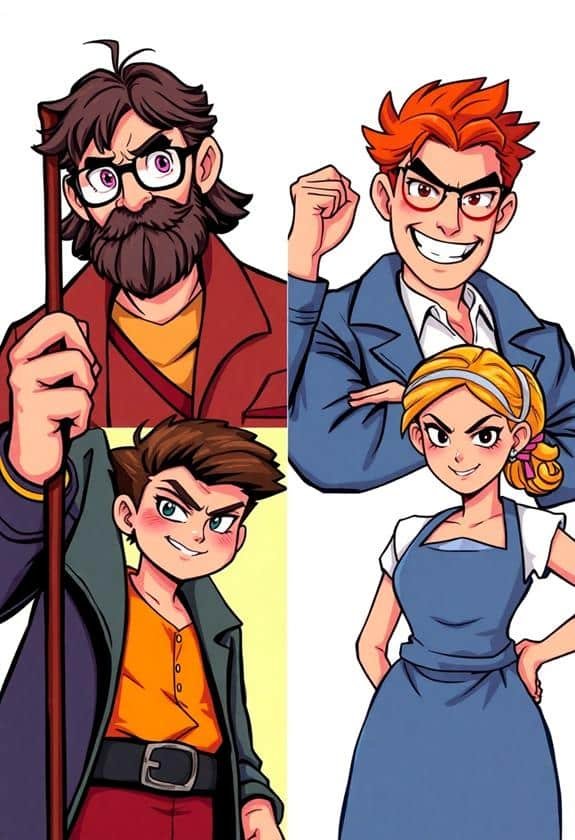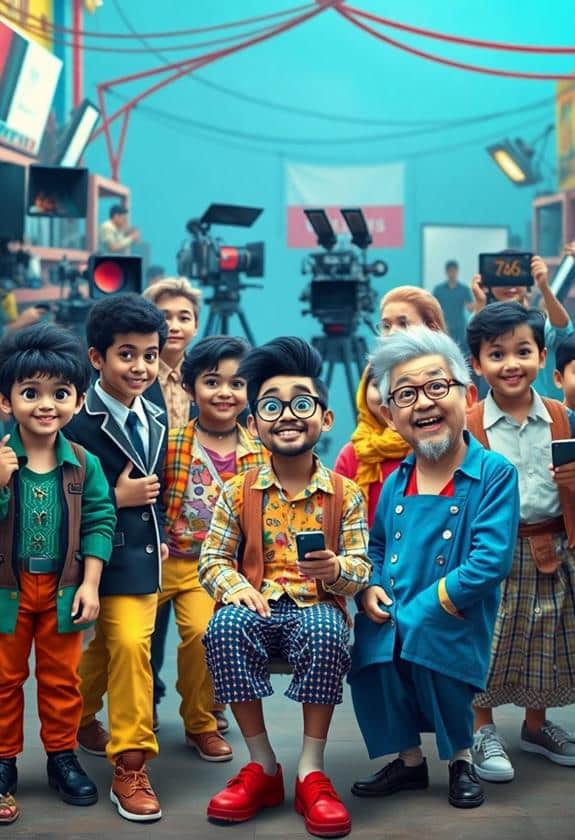Creating memorable characters for film starts with understanding who they are. Think of archetypes like the brave hero or the wise mentor—these can add depth. Give your characters compelling backstories to make them relatable; their childhood dreams or struggles can be powerful. Mix strengths and flaws—who doesn’t love a hero with a little heart? Unique personalities shine, too, often revealed through witty dialogue or meaningful relationships. Remember, characters grow! Let them evolve through their journeys. Just like how I discovered my characters in unexpected ways, you might find inspiration in your own life, and there’s so much more to explore!
Key Highlights
- Develop unique character archetypes by blending traditional traits with fresh twists to enhance relatability and depth.
- Create compelling backstories that shape characters’ motivations and reveal their dreams, making them more human and relatable.
- Establish clear goals and desires for characters, allowing for meaningful growth and transformation throughout the narrative.
- Use authentic dialogue that reflects natural speech patterns, mixing seriousness with humor to bring characters to life.
- Design visual representations, including costumes and body language, that align with characters’ personalities and arcs to enhance memorability.
Understanding Character Archetypes

Character archetypes serve as the foundational building blocks of storytelling in film, helping you quickly convey essential traits and motivations. When you think about characters, you might picture the brave hero, the wise mentor, or the cunning trickster. Each archetype has its strengths and weaknesses, making them relatable and memorable. Incorporating diverse storytelling elements enhances character development, much like how a filmmaker utilizes essential filmmaking equipment to bring their vision to life. Imagine writing a story where your hero, the classic underdog, faces seemingly impossible challenges. This character’s journey can inspire your audience, showing that perseverance pays off. Similarly, the mentor archetype can guide your hero, providing wisdom and support, like a cozy blanket on a chilly night.
Using archetypes isn’t just about filling roles; it’s a tool to connect with your audience. Think about how you can twist these archetypes to create fresh stories. For instance, what if your villain turned out to be misunderstood? It adds depth and makes your film more intriguing.
In my filmmaking adventures, I’ve learned that blending archetypes can lead to exciting results. So, as you craft your characters, remember to embrace these archetypes, but don’t be afraid to bend the rules. Your unique twist could be the spark that lights up your story!
Developing Backstories

Crafting compelling backstories is essential for giving your characters depth and relatability. When you take the time to develop a character’s history, you create a richer narrative that resonates with your audience. Think about it—everyone loves learning about how someone became who they are, right? Using affordable filmmaking gear can help you bring these characters to life on screen.
Here are some tips for developing backstories that engage and connect:
- Childhood Experiences: What shaped them as a kid? Did they have a favorite toy or a best friend who moved away?
- Key Life Events: Did they face any challenges that defined their path? Perhaps a family tragedy or a triumphant moment?
- Dreams and Aspirations: What do they want to achieve? A character with dreams feels more relatable and human.
- Relationships: Who are the important people in their lives? Friends, mentors, or rivals can all add layers to their story.
In my own filmmaking journey, I’ve learned that backstories can transform a flat character into someone the audience truly cares about. So, dive deep, have fun, and let your characters surprise you!
Crafting Unique Personalities

Creating unique personalities is essential for making your characters stand out in a crowded film landscape. Think about it—when you watch a movie, it’s often the quirky, relatable characters that stick with you long after the credits roll. To craft these personalities, start by mixing traits that seem at odds. For instance, consider how a character might interact with their environment using creative lighting techniques to enhance their mood, much like the effects of the Glide Gear BFS 100 Butterfly Scrim Diffuser can soften light and add depth to a scene. Imagine a shy, bookish hero who secretly dreams of being a rock star. That contrast creates depth and makes them feel real.
Don’t be afraid to play around with humor, too! I once wrote a character who was always trying to impress others with elaborate but completely impractical ideas. It was hilarious to watch them fail, but it also revealed their insecurities. Remember, characters don’t need to be perfect; their flaws make them relatable.
You can also draw inspiration from people around you. Observe friends, family, or even that eccentric neighbor who always wears mismatched socks. Incorporating unique quirks can add a delightful touch. Just remember, a character’s personality should serve the story, so keep it consistent with their actions. Embrace the challenge of creating characters that feel like they could step right off the screen and into your life!
Establishing Motivations

Motivation is the engine that drives your characters’ actions and decisions, making it essential to establish clear goals and desires. When you know what your characters want, you can create situations that challenge them and keep your audience engaged. Think about what makes your characters tick—what do they cherish, fear, or dream about? Additionally, consider how sound design, including the use of quality microphones, can enhance the emotional weight of your character’s motivations and decisions, creating a more immersive experience for your audience. Check out top microphones for filmmaking that can help capture those pivotal moments.
Here are some tips to help you establish motivation:
- Identify core desires: What’s at the heart of your character’s journey?
- Create obstacles: What’s standing in their way? Conflict makes motivation more interesting!
- Show growth: How do their goals change over time? A character’s evolution adds depth.
- Connect emotionally: Make their motivations relatable so your audience can see a bit of themselves in your characters.
I remember struggling with a character who seemed flat. Once I figured out their motivation—finding a place to belong—the story transformed! Your characters’ motivations can turn a good story into a great one. So, take the time to dig deep and discover what drives them; it’ll pay off in the end! Happy writing!
Creating Flaws and Strengths

Building well-rounded characters means figuring out their flaws and strengths. Think about it: no one’s perfect! If you give your characters relatable flaws, it makes them more human. For instance, let’s say your character struggles with being overly trusting. It can lead to some funny moments, like when they accidentally share secrets with the wrong people. But it can also create tension and conflict, driving the story forward. Plus, a well-crafted character can benefit from essential tools that enhance storytelling, such as the best editing equipment.
On the flip side, strengths can shine a light on your character’s positive traits. Maybe they’re incredibly resourceful, and able to solve problems in creative ways. This strength can inspire others and even save the day, but it can also lead to situations where they take on too much. You might recall feeling overwhelmed when trying to juggle school projects, right?
When you blend these flaws and strengths, you create depth. Your audience will root for them, even if they stumble. Remember, every challenge they face can turn into an opportunity for growth. So, as you write, think about what makes your characters tick. They’ll become memorable, and who knows? They might even teach you a thing or two!
Utilizing Dialogue Effectively

Crafting sharp, authentic dialogue can bring your characters to life and propel the narrative forward. Think about how you talk with friends; it’s often a mix of seriousness and fun. Your characters should reflect that same energy! When writing dialogue, consider these tips:
- Listen to Real Conversations: Eavesdrop a bit (just be respectful!). Notice how people interact, using humor, interruptions, and emotions.
- Use Unique Voices: Each character should have their own way of speaking. Maybe one uses fancy words, while another prefers slang.
- Keep It Natural: Avoid overly scripted lines. Let your characters stumble over words or trail off; that’s what real people do!
- Show, Don’t Tell: Instead of saying a character is angry, let their words drip with sarcasm or frustration.
I remember struggling with dialogue in my first screenplay. I wrote pages of boring conversations, but once I started listening to my friends, I found the magic! Dialogue is your chance to show personality, so embrace the quirks and let your characters shine. Happy writing!
Building Relationships

Often, strong relationships between characters can elevate your story and create emotional depth. Think about your favorite films—aren’t the moments between characters often the ones that stick with you? When building relationships, focus on how characters connect. Maybe they share a secret, support each other during tough times, or even have playful banter that makes you laugh.
For instance, consider a friendship where one character always encourages the other to step outside their comfort zone. You can show this by having them plan a fun adventure together, sparking excitement and a bit of fear. This not only shows their bond but also allows for growth.
Remember, relationships aren’t just about the big moments; it’s the little things that count too. A simple gesture, like one character bringing coffee to the other on a tough day, can say a lot.
As you write, think about how these relationships drive your characters’ actions. The more real and relatable you make them, the more your audience will connect. So, dive deep into those character interactions, and let their relationships shine—your story will thank you for it!
Visual Design and Appearance

Visual design and appearance play an essential role in making characters memorable. When you think about your favorite films, the characters often have distinct looks that immediately come to mind. You want your audience to connect with your characters visually, and that starts with careful design choices.
Consider these key elements:
- Color Palette: Colors can evoke emotions. Use warm tones for friendly characters and cooler shades for more mysterious ones.
- Costume and Accessories: These can tell a lot about a character’s background and personality. A quirky hat or a worn-out backpack can reveal so much!
- Physical Traits: Unique features, like a scar or a distinctive hairstyle, can make your character stand out. Think about how these traits can add depth to their story.
- Body Language: How a character holds themselves can say everything. Confident characters might stand tall, while shy ones may hunch over.
I remember struggling with a character’s design in my film. It wasn’t until I focused on these elements that my character truly came to life. So, immerse yourself in the visual world, and let your characters shine!
Character Arcs and Growth

Memorable characters don’t just look distinct; they also experience meaningful growth throughout the story. Think about your favorite films. Often, the characters you love are those who face challenges that change them for the better. You want your characters to start in one place and end up somewhere different—hopefully stronger or wiser.
For example, imagine a shy character who dreams of being a singer. In the beginning, they might hide in the shadows, terrified to share their talent. As the story unfolds, they face obstacles, like performing in front of a crowd or overcoming personal fears. With each challenge, they grow, gaining confidence and finding their voice.
When you write, consider what your character needs to learn or overcome. It’s like when I tried out for a play and flubbed my lines. I learned from my mistakes, just like your characters should! Their journey shouldn’t just be about external events; it’s about how those events shape who they become. By focusing on character arcs, you’ll create relatable characters that viewers can root for, and trust me, that’s what keeps your audience engaged from start to finish!
Testing Audience Connection

Creating a strong connection with your audience is essential for making characters truly resonate. You want viewers to feel something when they watch your film, and that starts with testing how your characters connect with them. Here are a few ways to gauge that connection:
- Feedback Sessions: Share your script or film with friends or small groups. Ask them about their feelings toward your characters.
- Surveys: Create simple surveys to gather opinions on character traits or storylines. This can give you valuable insights.
- Screenings: Host a screening and watch for audience reactions. Do they laugh, cry, or cheer? These moments matter!
- Social Media: Utilize platforms to engage with viewers. Ask them what they love or dislike about your characters.
I remember screening my first short film and noticing how people gasped at a character’s big moment. It was thrilling! Ultimately, the more you understand your audience’s reactions, the better you’ll be at creating characters that leave a lasting impression. So, embrace the feedback and let it guide your creative journey—you’ve got this!
Frequently Asked Questions
How Do I Avoid Clichés When Creating Characters?
To avoid clichés when creating characters, dig deep into their backgrounds and motivations. Think about what makes them unique—maybe they have an unusual hobby or a quirky fear. I once created a character who collected vintage lunchboxes! By giving them real emotions and flaws, you’ll make them relatable. Don’t be afraid to break stereotypes; it’ll make your characters stand out. Remember, everyone loves a good twist, so let your imagination run wild!
What Role Do Secondary Characters Play in Character Development?
Secondary characters are like the supporting cast in your favorite play; they help your main character shine! They can challenge, teach, or even bring out your protagonist’s quirks. Think of Ron and Hermione helping Harry Potter; without them, his journey would feel lonely. By giving these characters depth and unique traits, you create a richer story. So, don’t forget to let them grow alongside your main character—they’re key to development!
How Can I Ensure Diversity in My Characters?
To guarantee diversity in your characters, you’ll want to explore various backgrounds, cultures, and experiences. Think about the people in your life—how they shape your view of the world. Write characters who’ve got stories to tell, just like your friends! Read books, watch films, and listen to voices from different communities. You’ll not only enrich your story, but you’ll also create a world that feels welcoming and true to life.
Should Characters Reflect Real People or Be Entirely Fictional?
When you think about characters, they can be a mix of real people and pure imagination. It’s all about balance! Real experiences add depth, while fictional traits let you explore wild ideas. For instance, my friend once based a character on a quirky teacher, and it brought the story to life. Don’t be afraid to blend elements, because that’s where the magic happens! Just remember, every character should resonate with your audience.
How Do I Balance Character Complexity With Audience Understanding?
Balancing character complexity with audience understanding can be tricky, but it’s totally doable! Start by giving your characters relatable traits, like fears or dreams. You can dive deep into their backgrounds, but sprinkle hints throughout the story. Think of it like seasoning a dish; too much can overwhelm. For example, if your character loves skateboarding, show them practicing, and let their passion shine. Keep it simple, and your audience will connect, feeling right at home!
Conclusion
So, as you plunge into creating memorable characters, remember the old saying: “You never get a second chance to make a first impression.” Your characters should leap off the screen, flaws and all, and connect with the audience in a way that feels genuine. Think about the stories you love—what makes those characters stick with you? By pouring your heart into their journeys, you’ll craft unforgettable personalities that resonate. Now, go out there and bring your characters to life!




